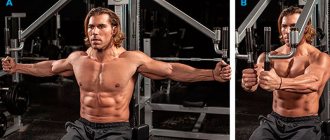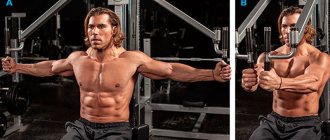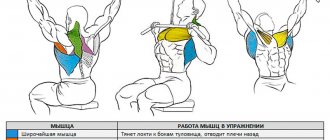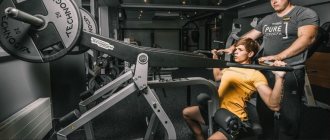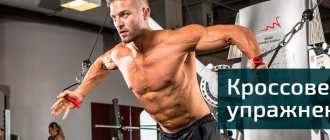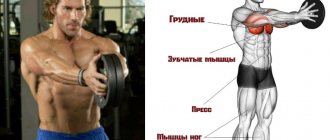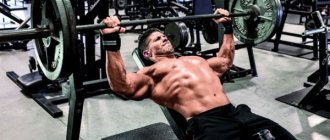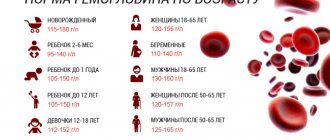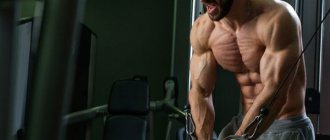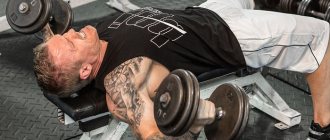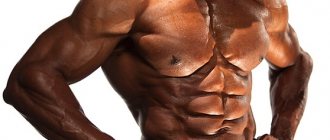Share:
The crossover crossover is an effective isolated exercise for developing the chest muscles. By performing it in different variations, you can focus the load on different parts of the pectoral muscles: upper, lower, inner or lower part. There are several basic variations of crossover hand movements: standing, lying on a bench, through upper or lower blocks. How to correctly do all variations of this exercise will be discussed in our article today.
Working muscles
The target muscles for this exercise are the pectorals. Depending on the variation of the exercise, it is possible to emphasize the load on their lower, upper or inner parts.
The pectoral muscles are targeted when performing the exercise.
The muscles of the shoulders, arms and back are used as additional muscles. A number of muscles in the body perform a stabilizing function. In particular, these are the muscles of the abs, legs and buttocks.
Advantages
Since performing the crossover exercise is an isolating exercise, the athlete improves brain control over the chest area. This means that regular execution will allow you to better strain the trained area in other exercises.
In addition, light weights allow you to do a large number of repetitions. This, in turn, allows you to work out bundles that are less loaded in other trips.
By performing the exercise, bodybuilders work out the central area of the chest, and give the muscles the correct shape and relief.
The advantage of crossovers
Performing exercises in a block simulator has its own specifics. As for such an exercise as a crossover, its main advantages are as follows:
- The pectoral muscles are under load all the time. The resistance of the blocks does not allow them to relax even for a second. While when performing chest exercises with dumbbells or a barbell, the effort is more of an impulse nature.
- By varying the position of the body and the direction of the information, you can work different areas of the pectoral muscles. So, for example, if we do a crossover from top to bottom, the lower chest is working. If, on the contrary, we pull up the handles of the lower blocks, the emphasis is on the top of the chest. By doing the crossover directly in front of us, we are working on the center.
- The crossover technique involves stretching the target muscles at the top. This allows you to increase the range of motion and force the muscle to contract as much as possible.
- Because this exercise doesn't use heavy weights, it's much safer for your shoulder joints than, say, a bench press.
Necessary equipment
To adduct the hip, you need a crossover - a special simulator designed for professional bodybuilding. It has a stable metal structure that can withstand heavy loads. On such a simulator you can perform various exercises to pump muscles using upper and lower blocks.
To make muscle contractions more effective, you can also use special leg weights. which are attached to the ankle. They can be made in the form of cuffs or bracelets filled with sand and have different weights - from 1 to 5 kg. This attribute can increase the load, which will speed up the pumping of the necessary muscles, and will also help to quickly build muscle tissue.
Don't forget about such an important detail as clothing. It should be breathable, lightweight, not restrict movement and made from natural materials.
Sweat that accumulates on the body under low-quality synthetic T-shirts and T-shirts can cause allergies, itching and redness, which will distract from activities and cause inconvenience.
The ideal clothing option for bodybuilding would be professional thermal underwear, which is designed for sports, so it will not cause discomfort during training.
Execution technique
Often in isolated exercises, technique plays a more significant role than the weight itself. Crossover is no exception. Our task is not to load the muscle to the maximum (there are basic exercises for this), but to make it work so that it grows in the way we need. Well, or in the case of using exercises for finishing, we are working with an already tired muscle, so heavy weights are also irrelevant.
Let's look at the crossover in its classic form, leaving the variations for last.
- Set the required weight on the machine. It should be the same on the right and left. Use a load that will allow you to perform movements completely under control, without jerking.
- Stand straight between the posts, bend slightly forward with your back straight. Place your feet shoulder-width apart, knees slightly bent. Some athletes put one leg forward for a more stable body position when bending over. This approach has its place, however, when using it, it is necessary to alternate the position of the legs from approach to approach. This will avoid asymmetry of the load on the right and left sides.
- Raise your hands and grab the handles of the blocks so that you feel a stretch in your pectoral muscles. The elbows should be bent (this rule remains the same throughout the entire movement), the shoulder blades should be pressed tightly against the back. Lock yourself in the starting position.
- As you exhale, without bending your back or changing the angle of your elbows, slowly and under control bring your arms together below you in front of you. The insides of your wrists should be facing each other. Concentrate on maximizing the strength of your pectoral muscles. At the bottom of the exercise, hold for 1-2 seconds. You can even slightly move one hand behind the other (alternately) to increase the amplitude.
- As you inhale, raise your arms again to the starting position.
The classic version of the crossover emphasizes the load on the lower chest.
When performing the exercise, do not allow your elbows to straighten. The angle of about 10 degrees is maintained all the time. With the correct technique, the trajectory of the brushes' movement resembles a semicircle. The back should remain straight at all times. Shoulders should be straightened.
It is also important to control muscle effort and not allow yourself to work with your arms. We train specifically the pectorals, remember this. Avoid jerking - the movement is carried out evenly, the muscles do not relax for a second.
What to replace the exercise with?
There are many people who want to train on this simulator. This issue is especially relevant for small semi-basement gyms, where there is no room for an extra barbell, and even more so for such a massive exercise machine.
How to replace bringing your hands together in a crossover if it is not possible to install the structure in the hall?
Some call the wiring a full replacement. But it's not that simple.
Since the dumbbells are a free weight, the athlete must exert extra effort to keep them balanced. This affects the nerve connection that switches from the pectoral to the shoulder muscles.
Although the movement is similar to a crossover, the muscles are not stretched as well.
The practitioner tries not to drop the projectiles down, which does not allow him to sufficiently relax the fibers.
There are also multifunctional exercise machines, on which the most frequent guest is the so-called butterfly. This is a pair of vertical surfaces, on which the athlete brings his elbows together.
This simulator allows you to focus more on chest isolation. Its disadvantage is insufficient stretching, which, due to the lack of static tension in the arms and shoulders, is greatly reduced.
However, it is possible to replace, although not fully, a crossover. To do this you need to use rubber bands.
By attaching them to the wall at a distance of 2 meters from each other, the athlete can perform scoring approaches at the very end of the workout.
The disadvantage is the difficulty of changing the load. However, this creates constant tension, similar to professional blocks.
Variations for the top and middle of the chest
As already mentioned, classic crossovers mostly target the lower chest. In fairness, it is worth citing variations of this exercise, the combination of which will help to maximally polish the shape of the pectoral muscles from all sides.
In general, the technique for performing the exercise remains the same, only the position of the body and the direction of pull of the cables change.
Upper chest
When our task is to draw the upper contour of the chest, the handles will need to be pulled not from top to bottom, but from bottom to top. That is, the exercise is performed on the lower block.
When using lower blocks, the load is redistributed to the upper chest.
In the starting position, the arms are slightly bent at the elbows, lowered down to the sides of the body and slightly pulled back (until you feel a stretch in the chest). Palms are directed towards the body. As you exhale, you need to raise your arms and bring them together in front of you. While inhaling, return to the starting position.
Mid chest
To work the middle of the chest, secure the blocks in the middle of the supports and perform the information directly in front of you. In this position, the arms at the end point will not be directed up or down, but forward.
Working on the central part of the chest.
You can also try a horizontal crossover. To do this, place a bench between the supports of the simulator. You lie down on it with your body and grab the handles of the blocks in the lower position. The load will be similar to what you get when doing dumbbell curls. However, thanks to the resistance of the simulator, your muscles will not relax for a second, that is, the workout will be even more powerful.
Execution on a horizontal bench.
Bringing hands together on a crossover[edit | edit code]
Main characteristics of the exercise:
- Crossover crossover - auxiliary exercise
- Isolation of one joint
- Traction movement
- Open kinetic chain
- Using weights
- For intermediate and advanced levels
Reduction of hands is performed on a crossover. The first examples of such simulators appeared on sale in the 1950s. Their inventor was the founder of fitness in America, Jack Lalenne.
Recommendations for pumping deltas
There is no universal exercise for the deltoid muscles. Basic exercises involve several bundles, but individual zones are still a priority. Therefore, the training program should include a variety of movements for all three beams.
It is extremely rare that this muscle group develops evenly. As a rule, some bundles lag behind - most often these are the back and middle ones, since they are either forgotten about, or the exercises are performed incorrectly, or they do not do enough work, concentrating on the presses alone. Over time, you can focus on these particular beams, starting your shoulder day not with a bench press, but with swings on the rear and middle deltoids. But at the initial stage it is necessary to lean on the base, while not forgetting to pay attention to each beam. For beginners, two or three movements will be enough. Experienced athletes use 2-4 basic and 2-4 isolation exercises.
The recommended number of approaches per movement is 3-5, the number of repetitions is 8-15. It is recommended to train your shoulders once a week. Only with specialization among experienced athletes can deltas be divided into bundles over two to three days.
Pay special attention to warming up. Shoulders are a complex complex that can be easily damaged. It makes sense to include shoulder movements in the program after training the large muscle groups of the body. This will prepare the deltoids for stress and reduce the risk of injury.
We recommend reading: Not just a barbell: how men can properly build muscle and not turn into a closet
If you experience pain in your joints and ligaments, stop training immediately. It is best in such cases to contact a specialist. By ignoring the problem, you risk missing out on pumping your case for several months.
Basic provisions
Despite the apparent simplicity of the exercise, there are also pitfalls. Not all athletes are able to properly contract their pectoral muscles on a crossover. It's all about the arrangement of bones and joints. The exercise is not basic, it is isolated. Therefore, you do not build muscle mass, but correct its shape. The exercise is suitable for experienced athletes in several cases:
- drying;
- formation of relief;
- reaching peak form;
- replacing old (boring) exercises.
The most controversial point is the position of the body in the crossover. Some trainers recommend scissors, but this is not entirely correct. The body must be symmetrical to maintain load balance. The position must be selected so as to achieve maximum stretching at the upper points. Your arms should not dangle - feel the chest tension. Pause at the bottom of the contraction.
On a note! Sunken chest is wrong. During deadlifts, fill your lungs with air and straighten your chest. This way you will achieve better cuts.
Exhalation is done with effort. After the contraction there is a short pause. Exhale as you straighten your arms. The knee joints are slightly bent - this will allow you to choose the optimal position for pumping the thoracic regions. The arms are constantly tense, the load is maintained throughout the entire distance.
Recommendations: how to pump up your rear deltoids
- In order for your shoulders to noticeably increase in volume, you need to work with more weight.
- It is important that the number of repetitions does not exceed 12 times, optimally 8-12.
- Both men and women need to feel a good load; it is the burning sensation in the muscle during the last repetitions that indicates the correct choice of weight.
- The last two repetitions must be performed with all your might - this is a very important condition.
Only if all recommendations are followed, muscle growth is ensured.
Girls do not necessarily need to develop their posterior delta with exercises in the weight training mode. The endurance mode is quite suitable - 15-20 repetitions of 3 sets, while the muscles will have a sporty and feminine appearance.
Also, do not overload , do no more than 1-2 workouts per week. Tired and overtrained muscles will not increase in volume and training will simply lose its meaning. Equally important for muscle growth is nutrition , especially after training. The formation of new muscle fibers requires proteins, fats and carbohydrates. It is proteins and carbohydrates that are the building materials and energy fuel for muscles. Eat 4-5 times a day, and after training, eat food within 40 minutes, and then you will get beautiful and shaped shoulders.
Contraindications
Contraindications include shoulder injury and torn pectoral muscles. But in principle, these are general points that will prevent you from performing almost any pressing movement.
Also, if you have pain in your elbow, you should first consult a doctor, and then decide whether to perform this movement or not.
Personally, I wouldn’t recommend doing it to beginners and would classify it as a contraindication. For them, exercise will only be a burden at the initial stage. And together with the result, a lot of effort and time will be spent. And the lack of results can break willpower and motivation.
Good luck to everyone in your training!
